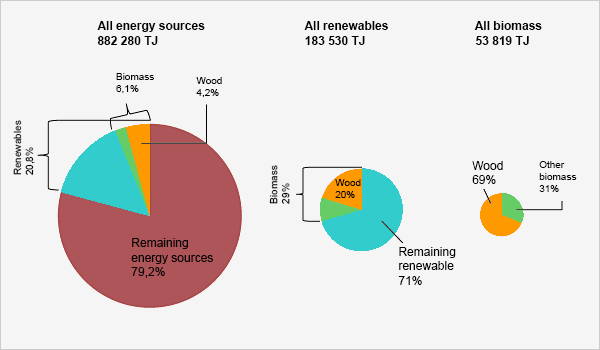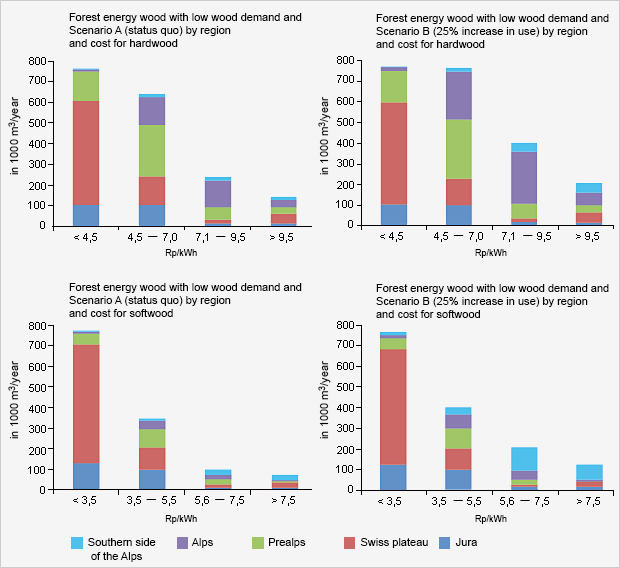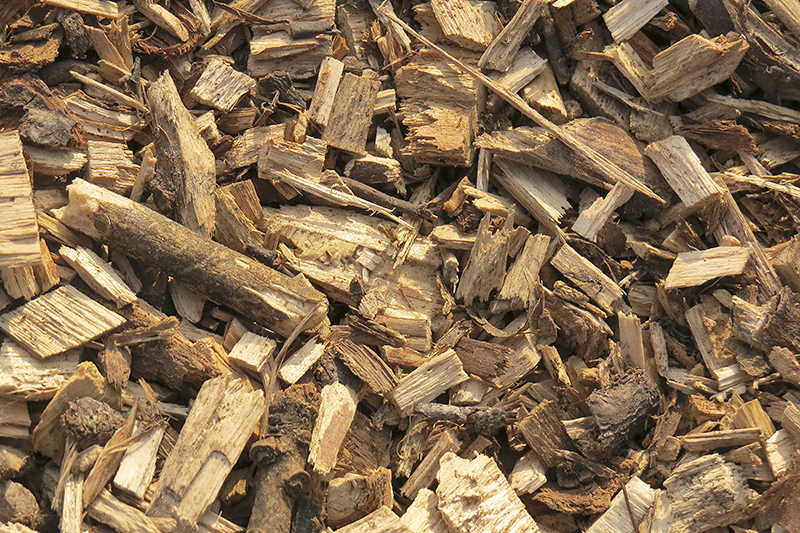In 2011, the Swiss Federal Council and Parliament took the decision in principle to phase out nuclear power. The planned implementation of the energy transition is likely to place increasing pressure on natural resources, with a resulting impact on the landscape. In the case of wood – a key renewable resource – this raises the question of the potential, opportunities and risks associated with the use of wood for energy in Switzerland.
As a renewable resource, wood will be one element in the energy system of the future. What role it plays in that system will depend on a competitive process involving all renewable resources and a residual share of fossil fuels. The outcome of this process will be shaped by technical and economic as well as political factors.
An appropriate way to examine this issue is to perform an analysis based on a market model. The main aims of such an analysis are to determine how much wood will be available and how great the need will be. To answer the first question, the supply of energy wood will need to be examined. Key factors here are the total amount used, the timber harvesting costs and the prices that could be achieved through an alternative use. The second question relates to the demand side, where technological development plays a role along with the prices of alternative energy sources.

Fig. 1 - Wood is currently the second most important energy source in Switzerland after hydropower. Photo: www.augenkick-webdesign.de / pixelio.
Categories and properties of wood
Energy wood is wood that is used to generate energy. It can be divided into five categories, according to its origin:
- Forest energy wood is wood produced in forests, harvested and used to generate energy. Forest wood makes up the biggest proportion of all categories, including, most notably, additionally useable potential (Fig. 4).
- Farmland wood includes all woody tree and bush compartments outside of forests. It is often referred to in German as Landschaftspflegeholz (managed landscape wood).
- Plantation wood refers to wood from plantations on agricultural land. Such plantations currently have no sustainable potential in Switzerland.
- Wood residues are natural residues from timber used by processing establishments, mainly sawmills. They contain a considerable proportion of bark.
- Waste wood is wood from building renovations or other material applications (e.g. furniture, packaging) which is not going to be reused in its current form. Such wood is mostly treated.
Wood has a high calorific value, can be stored and contains carbon. Its high calorific value makes it valuable for process heat while its storability makes it a complementary form of energy to fluctuating wind and solar power. Finally, wood is of value as a carbon resource since carbon-based energy sources (C fuels) are difficult to substitute in certain applications. Biogas from wood is one alternative.
Wood as a resource is produced constantly and in a decentralised way but in limited quantities. It is distinguished by its multiplicity of uses. This results in competition, for example between material and energy applications. Even within the energy domain, wood can be used for multiple purposes: to produce heat, to generate electricity or as a fuel. Furthermore, wood also lends itself to cascade use, serving initially as a material (multiple times, in some instances) before being converted into energy at the end of its life cycle.
Proportion of wood in energy supply
Overall, wood is a minor player compared with other energy sources. However, in terms of renewables alone, wood is currently the second most important energy source in Switzerland after hydropower. In the context of all biomass used for energy generation, wood occupies an even more significant position (Fig. 3). In recent years, the use of wood energy has increased, accounting for around 4% of Switzerland's total final energy consumption. The bulk of wood energy – 95% – is currently used for heat production.

Fig. 3 - Energy wood in the context of energy sources – Final energy consumption in 2012 in terajoules (TJ), (heat, electricity and fuel). Shown to scale, based on data from the Swiss Federal Office of Energy (SFOE).
Energy wood potential
Estimating the potential of wood resources is the basis for assessing the future role of wood in the energy system. This entails, on the one hand, calculating the verifiable and reliable potential and, on the other hand, identifying the factors that could alter that potential. The following types of potential can be distinguished:
- The theoretical potential is a maximum figure that is only theoretically attainable. It refers to the long-term average amount of wood that exists per year, without restrictions. The depletion of any stocks is not taken into account.
- The sustainable potential is obtained by subtracting from the theoretical potential the amount of wood not available for energy use due to restrictions or higher-value use. Restrictions may be technical, ecological, political, legal or economic in nature and are often interlinked. Examples include protective status for forests, the use of wood as a material and the inability of wood production revenue to cover costs.
- The already used potential was outlined briefly in the previous section.
- Of particular interest is the additionally useable potential. This is the difference between the sustainable potential and the amount already used. Consequently, potential data always includes information about resource availability.
Figure 4 shows the short-term potential of the different categories of energy wood at resource level. The total theoretical energy wood potential is 13.9 million m3/a. The sustainable potential amounts to 6.4 million m3/a, of which 4.2 million m3/a is already being used. A further 2.2 million m3/a is additionally useable. Significant additionally useable potential is limited to forest wood and – to a much lesser extent – waste wood.
Forest energy wood represents the biggest energy wood potential. Annual timber growth in Swiss forests corresponds to the theoretical potential and amounted to 9.7 million m3 in 2011. The sustainable potential is estimated as the average of two variants of a sustainable use scenario for the years 2017 to 2026 and totals 4.4 million m3/a. The already used potential stands at around 2.5 million m3/a (the proportion of wood used for energy but not recorded in forestry statistics was estimated roughly and rather highly). This results in an additionally useable volume of 1.9 million m3/a of forest energy wood, which must be interpreted as a conservative estimate.

Fig. 4 - Switzerland's energy wood potential by origin category, shown in quantities of wood (m3 of solid volume/year; forest wood 2017–2026, other categories 2011).
Energy wood supply
There are numerous risks and uncertainties that could result in the energy wood potential shown in Figure 4 not being exploited. This potential may be limited mainly for political and economic – in particular competition-related – reasons. Consequently, the parameters for forest energy potential in particular are not fixed, but rather depend on a multitude of factors. This makes it necessary to identify the main influencing factors (Tab. 1) and to analyse their impact over time.
| economic | ecological | political/social |
|
|
|
A key factor affecting the sustainably useable potential of forest energy wood is the amount of overall logging. The more timber that is harvested in total, the greater the amount of forest energy wood. The cause of this relationship lies in the joint production of stem, industrial and energy wood. All three main types of wood are contained in every strong tree, meaning that to harvest stem wood you also have to harvest industrial and energy wood.
The level of overall logging is ultimately determined by the market situation, since the potential of forest energy wood is largely dependent on whether it can be used economically. It is therefore important to know what quantities of energy wood can be supplied at what cost and how much the energy wood product can contribute to total forestry costs.
The first question involves making a differentiated assessment of the potential's short-term economic availability by means of a partial-cost analysis. To this end, the costs of providing the timber in the form of forest woodchips were calculated (Fig. 5). The data relates to the scenario of low wood demand as well as scenarios A (status quo) and B (25% increase in use). The costs of timber provision are a key factor in determining the economic viability of wood energy systems as a whole and hence the exploitation of additionally useable wood energy potential. To improve availability, costs must be reduced throughout the supply chain.

Fig. 5 - Costs of provision (harvesting, chipping and transport costs) for soft and hard forest energy wood (m3 of merchantable wood and brushwood with bark) for use scenarios A (status quo) and B (25% increase in use) for a timber market unfavourable to energy wood in the period 2017 to 2026.
With the second question, the focus lies on the potential's long-term availability, as determined by a full-cost analysis examining the extent to which the total costs of woodchip provision can be met from the revenues generated by such chips. A study looking at the Canton of Aargau found that current energy woodchip prices only cover on average two-thirds of the cost of provision. The challenge, therefore, is to ensure the sustainable competitiveness of energy wood as a product by lowering costs.
Energy wood demand
Energy wood consumption is currently on an upward trend, as are energy wood prices. However, this does not appear to be the case for the competitiveness of forest energy wood as a product (woodchips), as the Aargau example showed, although the situation is even worse when it comes to the recycling of such wood as industrial timber.
The Energy Strategy 2050 assumes, under the New Energy Policy (NEP) scenario, that wood will be increasingly used for electricity generation in the medium and long term (up to 2050), in contrast to the current situation. On the other hand, the use of wood to produce heat is set to decline sharply. The scenario also assumes a big increase in biofuels, suggesting an increase in demand for wood. However, the scenario does not specify which materials are to be used as biofuels. Ultimately, the form of wood energy used will be determined locally, based on its competitiveness compared with technologically viable alternatives.
Biogas from wood and other types of biomass of natural gas quality, produced and injected into the gas network, enables a flexible and demand-oriented energy supply: it can be stored easily at times of low consumption, while during peak demand periods or when other renewable energy sources are unavailable, it can be used to meet heating and power generation needs. Wood therefore offers greater added value and contributes to a lower-carbon energy supply, meaning that the forestry sector, despite its limited resource, is set to become an important service provider by enabling a flexible and demand-oriented energy supply.
Demand will also be stimulated by the fact that wood-based heat and power generation creates a strong substitution effect, with a reduction of up to 90% in fossil CO2 emissions. It is clear, therefore, that wood can play an important role in the energy system of the future.

Fig. 7 - The Energy Strategy 2050 assumes, that wood will be increasingly used for electricity generation. The use of wood to produce heat is set to decline sharply.
Photo: Andreas Morlok / pixelio.de
Political and social framework
The discussion so far has focused mainly on economic factors, as these have a very big impact and can be influenced by the forestry sector itself. However, political and social factors also play a role (Tab. 1). One example is the promotion of near-natural forests, which results among other things in a higher proportion of hardwood. The higher the proportion of hardwood, the greater the energy wood potential.
Also important is the intensity of use. Over-intensive use of (energy) wood can lead to a loss of biodiversity if too little dead wood remains in the forest. It can also impair nutrient supply, since whole-tree harvesting, including branches and brushwood, entails the removal of nutrients. However, because an excessive use of energy wood is not currently on the horizon, all in all there are not expected to be any serious negative consequences for ecosystem services in Switzerland, at least in the short and medium term.
Biomass for Switzerland's energy future
The Swiss Competence Centre for Energy Research - Biomass for Swiss Energy Future (SCCER BIOSWEET) is a consortium of 15 partners from academic institutions and 50 private and public sector organisations. It aims to meet the challenges of the Energy Strategy 2050 by using new technologies to promote the biochemical and thermochemical conversion of biomass into energy.
SCCER BIOSWEET wants to help make available an additional 100 petajoules of bioenergy, with wood, biowaste/manure and algae each contributing a third to this ambitious goal. This is roughly a doubling of current energy supply from biomass.
Starting points for generating an additional 33 petajoules of wood energy – an increase of almost 50% compared with today – include the following:
- An increase in overall wood use will also mean an increase in the amount of energy wood.
- Changes to wood types, e.g. from industrial to energy wood.
- The proportion of hardwood is forecast to rise in the coming decades. This will mean an increase in the amount of energy available, because hardwood stores more energy per cubic metre and because the proportion of energy wood types is higher, on average, in hardwood trees.
- Boosting efficiency to ensure that energy wood production covers more of its own costs.


